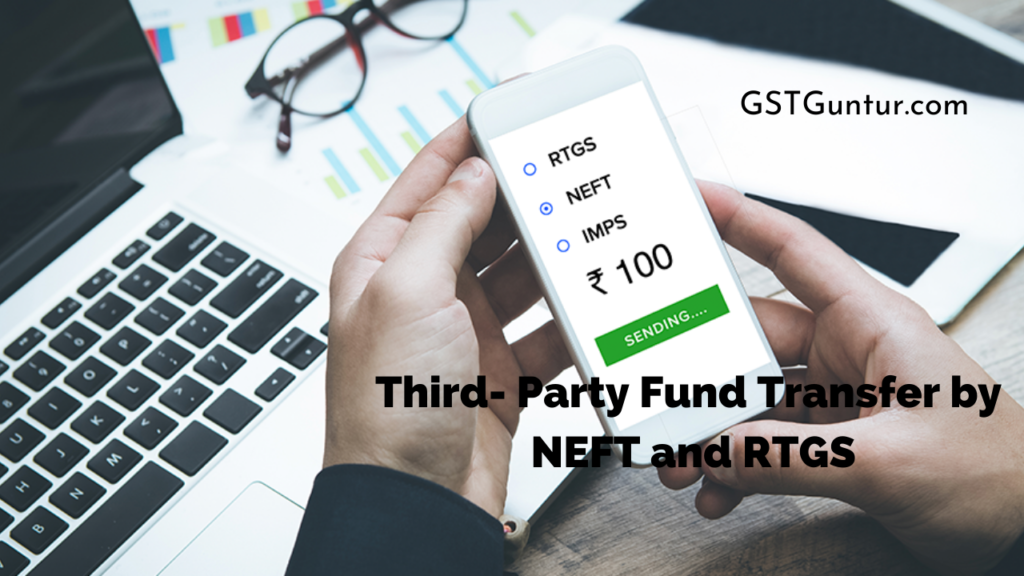Third-Party Fund Transfer by NEFT and RTGS: In the banking industry, a third party transfer involves making out and depositing payment in the account of one party apart from the individual or the entity who received the payment. It is the type of activity that has become common in the banking industry for many years.
People can manage it manually or by electronic transfer technology as well. A third-party transfer involves the issuance of third-party checks as well. Many online third-party transfer protocols manage the tasks such as paying bills, recharging, etc., with the help of a fund transfer.
People in the previous decade approached this type of transfer with checks. In such a case, a check can is a payment that a buyer issues to the seller. Instead of depositing that check into the seller’s account directly, the seller could choose to endorse the check over to another third party and possibly settle an outstanding debt. The bank or the third party could therefore accept the statement by using the endorsement as an authority.
More recently, people have started to manage bill payments by having the same third-party transfer made electronically. Hence, a bank customer can provide a bank with a written application to request a price from a specific creditor when or as required.
Sometimes, it is not an unusual practice for the creditor to use another third-party agency to manage the financial transactions on behalf of the creditor upon interaction with the bank to complete the transfer of funds from one account to another.
Therefore, the creditor can present the bill electronically to the bank and make the payment process without delay. People use it to manage everything ranging from paying monthly utility bills to mortgage and car payments. They can even schedule other recurring expenses, such as the payment of life insurance premium policies.
- Types of Electronic Fund Transfers Available
- Importance of Electronic Fund Transfers
- Necessary Terms Users Should be Familiar With for Third-Party Fund Transfers
- Registration for Third Party Fund Transfer
Types of Electronic Fund Transfers Available
As mentioned earlier, there are multiple fund transfer services through internet banking with your account, such as
- If you wish to transfer funds into your account, for example, from your savings account or current account to your PPF account, you can select the Fund Transfer option.
- If you require to transfer funds to a third-party account in the same bank, in the same branch or a different branch, you can select the option Fund Transfer within the same bank.
- If you require to make a transaction to another bank in a different account, you can select Interbank Transfer for fund transfer to a creditor who has an account in India. People carry out such interbank transfer through NEFT transfer or RTGS transfer.
- People can pay their credit card bills online.
Even if you want to select a transaction type as above, there still can be some confusion since different banks have different terms in their net banking sites. For example, SBI says Third Party Transfer as Transfer fund to third party account in the same bank. But, fund transfer to other banks means that you have to select the NEFT or RTGS transfer option.

Importance of Electronic Fund Transfers
Many are not used to net banking processes and wish to stick to the old method of transfer via visiting banks. But, electronic fund transfers are a secure procedure. It is also a relatively fast and cheaper way of transferring money (since you do not have to travel to and from the bank).
- No one has time to stand in a queue and wait to transfer money to someone in modern times. It is inefficient to visit the bank. But through electronic fund transfers by NEFT and RTGS, people can save much time and effort. For example, a cheque usually takes two or three days to clear, and if it is an outstanding cheque, it requires one more day. In a contrasting situation, people use electronic transfers to transfer money directly to a beneficiary with instant confirmatory updates for you and the receiver.
- The RTGS and NEFT processes cost less than issuing a cheque or a DD since the bank has to bear fewer charges.
Necessary Terms Users Should be Familiar With for Third-Party Fund Transfers
When it comes to NEFT or RTGS, there are specific terms associated with each of them. Knowing these can be helpful to make a successful transaction on the very first attempt. The words are as follows.
- Beneficiary Account: The account to which one makes a deposit or fund transfer is called the beneficiary account. Hence, the person who credits from the transaction is the beneficiary.
- Remitter: If someone sends a payment to a beneficiary through Third Party Fund Transfer, then they are called a remitter.
- RTGS: Real-Time Gross Settlement is the transfer where the beneficiary bank has to credit the beneficiary account within two hours of receiving the fund transfer message.
- NEFT: National Electronic Funds Transfer is the transfer on a net basis. Here, the bank clubs the transactions together, and the net amount is transferred.
Registration for Third Party Fund Transfer
Though each bank has its own policy that people need to follow to register for third-party transactions, the introductory details are the same. The steps you can follow to register are as follows.
- Log in to Net Banking using the required details, i.e. customer ID, customer name and IPIN.
- Some banks then send an OTP, which you have to input to log in to the site.
- Click on the Third Party Transfer option, and there will be instructions present which you can follow.
- If you are registering a new beneficiary’s account number for the first time, then you will first receive an OTP for approval. After that, there will be a short period of delay that is required to activate the new beneficiary.
- You will receive a one-time password or OTP to your registered mobile number for confirmation.
The key with a third-party transfer is that you have the authorization to manage the transaction by introducing a third party. The account holder can seamlessly transfer funds to the beneficiary in no time, and they will receive a confirmation after completion of the successful transaction or otherwise. People who are new to this can read the instructions carefully and contact the branch for further assistance.
Since this type of transaction has proper documentation without requiring any extra time, it is becoming an increasingly common aspect of fund transfer for business enterprises and individual account holders who prefer the intelligent way of paying bills with minimum effort and time.
